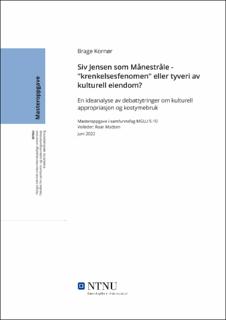| dc.contributor.advisor | Roar Madsen | |
| dc.contributor.author | Brage Kornør | |
| dc.date.accessioned | 2022-07-07T17:22:19Z | |
| dc.date.available | 2022-07-07T17:22:19Z | |
| dc.date.issued | 2022 | |
| dc.identifier | no.ntnu:inspera:110859567:30920450 | |
| dc.identifier.uri | https://hdl.handle.net/11250/3003703 | |
| dc.description.abstract | Formålet med denne oppgaven er å identifisere og analysere ideene i et utvalg kilder hvor det foregår diskusjon rundt kulturell appropriasjon og kostymebruk. Denne oppgaven gjør dette ved å bruke metoden ideanalyse med bruk av dimensjoner. Dimensjoner kan forstås som større grupper ideer, satt i et konstruert spekter. Datamaterialet som er analysert er en sending av TV-programmet Debatten fra 2021, og seks andre nettavisartikler som diskuterer Siv Jensens bruk av et «indianerkostyme» fra 2017. Analysen er også utført med oppgavens referanselitteratur som noe foreliggende å «basere» ideene på. Denne litteraturen er; Mats Alvessons Extra Allt!, Frank Furedis Why borders matter, og Francis Fukuyamas Identity. Studiens resultater viser til ideer innenfor fire dimensjoner:
- Råderetten over kulturmarkører. Alle ideene som er funnet her viser til at noen har noe form for råderett over kulturmarkører, men at det varierer hvor «sterkt» denne råderetten står. Det er også funnet ulike normative oppfatninger av fenomenet kulturell appropriasjon.
- Intensjon og mottakelse. Enkelte ideer tilsier at intensjonen bak handlingen av kulturell appropriasjon skal være avgjørende, mens andre viser til at mottakelsen burde anses som viktigst. De fleste ideene er like i oppfattelsen om at begge disse er viktige moment innenfor denne oppgavens tematikk.
- Historiske faktorer. I all hovedsak er det funnet ideer om at historiske faktorer burde (i varierende grad) være med i avveininger om nåtidige problemstillinger rundt minoriteters kultur.
- Ytringsrom. Her er det stor variasjon mellom ideene som er funnet. Det er funnet alt fra kritiske holdninger til identitetspolitikk og «krenkekultur» til ytringer som kan tolkes til at utelukkende de som er eller anser seg som berørt av en sak (i negativ forstand), kan ytre seg om den.
Ut fra oppgavens drøfting vises det også til et knippe andre konklusjoner. Identitetspolitikk kan sees på som bakenforliggende og relevant for diskusjoner rundt kulturell appropriasjon og kostymebruk. Kulturell appropriasjon kan sees på som en nøytral handling, eller det kan bli sett på som tyveri og/eller urettmessig bruk fra kultureksterne. Lagen om offerhierarkin, lagen om den krampaktige godheten og lagen om bumerangeffekten (fra Alvesson) er også å «kjenne igjen» i ideene funnet i denne oppgaven. | |
| dc.description.abstract | The purpose of this thesis is to identify and analyse the ideas from a selection of sources where there is a discussion around the topic of cultural appropriation and the use of costumes. This text does this by using the method idea analysis, and through the use of dimensions. Dimensions can be understood as larger groupings of ideas, put in a constructed spectrum. The empirical basis of this study is one publication of the TV-program Debatten from 2021, and six other news articles that discuss Siv Jensens use of an “indian” costume from 2017. The identification and analysis of ideas also took place with the thesis’ reference literature in mind. This literature is comprised of; Mats Alvesson’s Extra Allt!, Frank Furedi’s Why Borders Matter, and Francis Fukuyama’s Identity. The results of this study shows ideas found within four dimensions:
- Right of use of cultural markers. All the ideas found indicate that someone has some right of use over cultural markers, but the ideas vary in how “strongly” this right of use is perceived. There has also been found differing normative ideas regarding the cultural appropriation phenomenon.
- Intent and reception. Certain ideas state that the intent behind the action of using cultural markers from other cultures should dictate if the action is permissible/good. Other ideas show that the reception of the culturally external use of cultural markers should be regarded as the most important aspect. Most of the ideas found within this dimension show that both concepts play a key role within the “theme” of cultural appropriation and the use of costumes.
- Historical factors. Nearly all the ideas found show that historical factors should play a role in the handling of contemporary issues regarding minority cultures.
- “Freedom of speech” The ideas found within this dimension show great variation. Everything from critical attitudes towards identity politics and “krenkekultur” (“offended culture”), to statements that can be interpreted to that exclusively those directly touched (in a negative sense) by a case/event/phenomenon can speak about it.
There are also a few other conclusions drawn in the discussion chapter of this study. Identity politics can be regarded as an underlying “phenomenon” for discussions about cultural appropriation and costume use. The act of cultural appropriation can be viewed as a neutral action, or it can bee seen as thievery and/or as wrongful use of cultural markers by culturally external persons. Lagen om offerhierarkin (The law of the hierarchy of victims), lagen om den krampaktiga godheten (the law of “automatic” kindness), and lagen om bumerangeffekten (the law of the boomerang-effect) (from Alvesson) can also be said to apply the findings of this study. | |
| dc.language | nob | |
| dc.publisher | NTNU | |
| dc.title | Siv Jensen som Månestråle - "krenkelsesfenomen" eller tyveri av kulturell eiendom? | |
| dc.type | Master thesis | |
